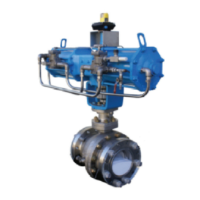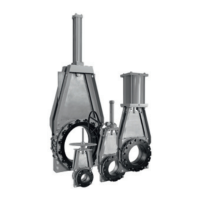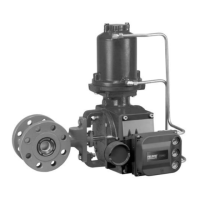5
KTM POWDER DISCHARGE SYSTEM (PDS) METALTITE
®
BALL VALVES
INSTALLATION, OPERATION AND MAINTENANCE INSTRUCTIONS
CAUTION
1. Ensure that there are no solid objects such as
pieces of wood, plastic or packing materials
within the valve or on the valve seat. It is
recommended to flush pipes before installing
the valve. If this is not possible, the installed
valve must be in its open position before
flushing takes place.
2. Unless otherwise recommended by KTM, the
valves should be installed with the ball in open
position to ensure that the seat rings are not
damaged during installation.
3. Use appropriate gaskets which comply with
standards or specifications.
4. Tighten the flange bolts with a closed wrench,
using a “crisscross” pattern that alternately
tightens the bolts located 180 degrees apart
(see Figure 1). Unequal partial tightening
places stress on lined pipes which may
damage the flange or produce excessive
operation torque.
5. Failure to fabricate pipes without excessive
stress will result in leakage, poor operation
or failure of the valves.
6. When conducting a pressure test of the pipe
system, the valves should be in a partially open
position. Testing at closed position will impose
too much load and will cause leakage from
seats. Check for any leakage from the joint
flange and gland portion during the pressure
test. After conducting the pressure test, return
to fully open/closed position at once.
7. If the piping system is pressurized with water
for testing, and if the piping system has been
shut down for a long time after testing, the
following measures should be taken:
• Use corrosion inhibitor with water to
pressurize the piping system.
• After testing, the piping system should be
depressurized and the test water completely
drained.
• Ensure that the corrosion inhibitor does not
leave a residue within the system as the
particulates may damage the valve sealing
surfaces.
FIGURE 1
Tightening of bolts
FIGURE 2
Lever handling valve
FIGURE 3
Gear operated valve
7 OPERATION
7.1 Operation instruction
Valve adjustment is performed through lever
handle/gear operation. Turning the stem
clockwise shuts the valve. Check the operation
of the valve by stroking it to “fully open” and
“fully closed”. Either the hand lever or the
direction of the parallel flats on the top of the
stem indicate the open or close position of the
KTM ball valves (Figure 2). For gear operated
valves, the position is indicated by the arrow-
indicator (Figure 3).
WARNING
1. Operate the valve taking up a stable posture,
after checking that the specified handle
is fastened by bolts/nuts or snap ring/set
screw. Also, when operating the valve with
a spare handle, please make sure that the
handle is reliably inserted into the stem’s end.
Insufficient insertion and forced operation of
the handle may result in damage or injury if
the handle slips out.
2. Excessive handle operation may break the
lever, injure the operator, and/ or deform the
stopper or the stem, which may also result in
seat leakage.
3. Be careful in handling the valve where high
temperature fluid flows in the pipeline. The
heated valve may cause burn injury of bare
hands.
7.2 Gear operated valve adjustment
If the gear-operated mechanism indicator
does not correctly indicate whether the valve
is completely open or shut, adjust the opening
with the adjustment screw. For details, refer to
document No. C325-330, “Instruction Manual of
A, B, C and D typed Gear Operational Valves”.
Valve closed Valve opened
Indicator

